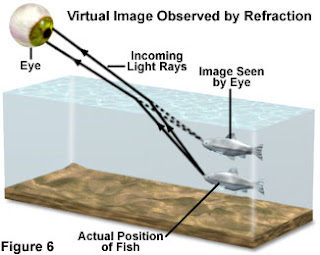Refractive Errors
Refractive error is the most
common visual problem
This defect prevents light rays
from converging into a single focus on the retina
REFRACTION:
Refraction of light occurs when
light passes from one medium to another of different refractive index (ie.
density)
Refractive Components of the
Eye: Cornea, Aqueous humor, Lens, Vitreous humor
REFRACTIVE ERRORS
MYOPIA (Near Sightedness)
· Causes light rays to be focused in
front of the retina
· Myopia may occur because of excessive
light refraction by the cornea or lens or because of an abnormally long eye.
· There is inability to accommodate for
objects at a distance
[next]
HYPEROPIA (farsighted)
· Causes the light rays to focus behind
the retina & requires the patient to use accommodation to focus the
light rays on the retina for near & far objects.
· This type of refractive error occurs
when the cornea or lens does not have adequate focusing power or when the
eyeball is too short.
[next]
ASTIGMATISM
· Is caused by an irregular corneal
curvature
· This irregularity causes the incoming
light rays to be bent unequally.
· Consequently, the light rays do not
come to a single point of focus on the retina. Occur in conjunction with any of the
other refractive errors.
[next]
PRESBYOPIA
· Is the loss of accommodation
associated with age.
· This condition generally appears at
about age 45yrs.
· As the eye ages, lens becomes larger,
firmer & less elastic
· These changes, which progress with
aging, decrease the eye's accommodating ability
· There is an inability to accommodate
for near objects
[next]
APHAKIA
· Is defined as the absence of the lens.
· The lens may be absent congenitally or
it may be removed during cataract surgery or a perforating wound or ulcer.
· The absence of the lens results in a
significant refractive error
· Without the focusing ability of the
lens, images are projected behind the retina.
[next]
MANAGEMENT
a. Nonsurgical Corrections
l. Corrective glasses
· Myopia- minus corrective glasses
(concave)
· Hyperopia-plus corrective lens
(convex)
· Presbyopia -plus corrective lens
(convex)/ Reading glasses
· Presbyopia+myopia or astigmatism-
combined glasses with bifocal or trifocal lower glasses OR 'no-line' bifocal
(multifocal)
· Aphakia- plus corrective lens (convex)
which are very thick, heavy and unattractive.
2.Contact lenses
· Provide better vision than glasses
· Made from various plastic and silicone
substances
· The person must remove contact lenses
immediately, if any of the following problems occur..
o l. Redness
o 2. Sensitivity
o 3. Vision problems
o 4. Pain
[next]
Types of contact glasses
Rigid Lenses:
1. Standard Rigid Lenses
· Rigid plastic; smaller than cornea.
· Long lasting, least expensive to
purchase; corrects all types of pass through the cornea refractive errors.
· Daily wear.
· Requires separate care solution
2. Gas Permeable rigid lenses
· Similar, but plastic allows oxygen to
pass through the cornea
· Long lasting, more comfortable; flexible wearing schedule.
· More expensive and requires separate
care solution
Soft Lenses:
· Standard
· High water content
· Toric
· Disposable
· Daily disposable
Corneal molding, also called as
orthokeratology, is the sue of specially designed, rigid, gas permeable contact
lenses to alter the shape of the cornea.
[next]
SURGICAL THERAPY
These are designed to eliminate
or reduce the need for eyeglasses or contact lenses and correct refractive
errors by changing the focus of the eye.
Surgical management include
· Laser surgery
· Intraocular lens (IOL) implantation
· Thermal procedures
l. Laser assisted in situ
keratomileusis (lasik)
· For patients with low to moderately
high amounts of myopia, hyperopia, and astigmatism.
· Using a laser or surgical blade to
create a thin flap in the cornea.
· Using new technology called 'wave-front'
the laser is then programmed to use a map of the patient's cornea to sculpt the
cornea and correct the refractive error.
· The flap is then repositioned and
adheres on its own without sutures in a few minutes.
· placed in front of the natural lens.
2. Thermal procedures
· Laser thermal keratoplasty (LTK)
· Conductive keratoplasty (CK)
· For patients with hyperopia or
presbyopia
· Using laser or high radio frequency,
heat is applied to the peripheral area of the cornea to tighten it like a belt
and make the central cornea steeper.
· Only the less dominant eye is treated
3. Photorefractive keratectomy (PRK)
· Indicated for low to moderate amounts
of errors.
· Good option for a patient with
insufficient corneal thickness for LASIK flap.
· Only the epithelium is removed and the
laser sculpts the cornea to correct the refractive error
Implants
· Intra corneal ring segments (ICRs) are
2 semi-circular pieces of plastic that are implanted between the layers of the
cornea to treat mild myopia
· Refractive intraocular lens
(refractive IOL) for patients with high degree of myopia or hyperopia. Involves
removal patients natural lens and implantation of IOL
· Phakic intraocular lenses (phakic
IOLs) for patients with high degree of myopia or hyperopia. IOL is placed in
front of the natural lens.
4. Thermal procedures
· Laser thermal keratoplasty (LTK)
· Conductive keratoplasty (CK)
For patients with hyperopia or
presbyopia
Using laser or high radio
frequency, heat is applied to the peripheral area of the cornea to tighten it
like a belt and make the central cornea steeper.
Only the less dominant eye is
treated




















COMMENTS